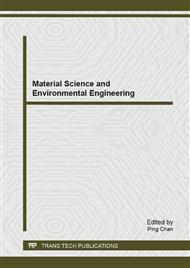[1]
G. Muyzer and A.J.M. Stams, The ecology and biotechnology of Sulphate-reducing bacteria, Nat. Rev. Microbiol. 6 (2008) 441-454.
DOI: 10.1038/nrmicro1892
Google Scholar
[2]
S.M. Keith, R.A. Herbert, C.G. Harfoot, Isolation of new types of Sulphate-reducing bacteria from estuarine and marine sediments using chemostat enrichments, J. Appl. Bacteriol. 53 (1982) 29-33.
DOI: 10.1111/j.1365-2672.1982.tb04731.x
Google Scholar
[3]
R.J. Parkes, G.R. Gibson, I. Mueller-Harvey, W.J. Buckingham, R. Herbert, Determination of the substrates for Sulphate-reducing bacteria within marine and estuarine sediments with different rates of Sulphate reduction, J. Gen. Microbiol. 135 (1989).
DOI: 10.1099/00221287-135-1-175
Google Scholar
[4]
F. Bak and N. Pfennig, Sulfate-reducing bacteria in littoral sediment of Lake Constance, FEMS Microbiol. Ecol. 85 (1991) 43-52.
DOI: 10.1111/j.1574-6968.1991.tb04696.x
Google Scholar
[5]
P. Caumette, Ecology and physiology of phototrophic bacteria and Sulphate-reducing bacteria in marine salterns, Experientia. 49 (1993) 473-481.
DOI: 10.1007/bf01955148
Google Scholar
[6]
J.R. Postgate, TheSulphate-Reducing Bacteria, Cambridge U. Press. London (1984).
Google Scholar
[7]
F. Widdel, and N. Pfennig, Bergey's Manual of Systematic Bacteriology, Williams & Wilkins, Baltimore 1 (1984) 663-679.
Google Scholar
[8]
R. Cord-Ruwisch, W. Kleinitz, and F. Widdel, Sulfate-Reducing Bacteria and Their Activities in Oil Production, J. Pet. Technol. 39 (1987) 97-106.
DOI: 10.2118/13554-pa
Google Scholar
[9]
A. Suarez-Suarez, A. Lopez-Lopez, A. Tovar-Sanchez, P. Yarza, A. Orfila, J. Terrados, J. Arnds, S. Marques, H. Niemann, P. Schmitt-Kopplin, R. Amann, R. Rossello-Mora, Response of sulfate-reducing bacteria to an artificial oil-spill in a coastal marine sediment, Environ. Microbiol. 13 (2011).
DOI: 10.1111/j.1462-2920.2011.02451.x
Google Scholar
[10]
M. Rzeczycka, and M. Blaszczyk, Growth and activity of Sulphate-reducing bacteria in media containing phosphogypsum and different sources of carbon, Pol. Environ. Stud. 14 (2005) 891-895.
Google Scholar
[11]
G.E. Jenneman, M.J. McInerney, and R.M. Knapp, Effect of nitrate on biogenic sulfide production, Appl. Environ. Microbiol. 51 (1986) 1205-1211.
DOI: 10.1128/aem.51.6.1205-1211.1986
Google Scholar
[12]
I. Davidova, M.S. Hicks, P.M. Fedorak, J.M. Duflita, The influence of nitrate on microbial processes in oil industry production waters, J. Ind. Microbiol. Biotechnol. 27 (2001) 80-86.
DOI: 10.1038/sj.jim.7000166
Google Scholar
[13]
Q. He, Z. He, D.C. Joyner, M. Joachimiak, M.N. Price, Z.K. Yang, H.C.B. Yen, C.L. Hemme, W. Chen, M.M. Fields, D.A. Stahl, J.D. Keasling, M. Keller, A.P. Arkin, T.C. Hazen, J.D. Wall, J. Zhou, Impact of elevated nitrate on sulfate-reducing bacteria: a comparative study of Desulfovibrio vulgaris, ISME. J. 4 (2010).
DOI: 10.1038/ismej.2010.59
Google Scholar
[14]
R.J. Parkes, N.J.E. Dowling, D.C. White, R.A. Herbert, G.R. Gibson, Characterization of sulphate-reducing bacterial populations within marine and estuarine sediments with different rates of sulphate reduction, FEMS. Microbiol. Ecol. 102 (1993).
DOI: 10.1111/j.1574-6968.1993.tb05815.x
Google Scholar
[15]
D. Shao, Y. Kang, A. Wu, M.H. Wong, Effects of sulfate reducing bacteria and sulfate concentrations on mercury methylation in freshwater sediments, Sci. Total. Environ. 424 (2012) 331-336.
DOI: 10.1016/j.scitotenv.2011.09.042
Google Scholar
[16]
K.T. Finneran, M.E. Housewright, and D.R. Lovley, Multiple influences of nitrate on uranium solubility during bioremediation of uranium-contaminated subsurface sediments, Environ. Microbiol. 4 (2002) 510-516.
DOI: 10.1046/j.1462-2920.2002.00317.x
Google Scholar
[17]
J.D. Istok, J.M. Senko, L.R. Krumholz, et al. In situ bioreduction of technetium and uranium in a nitrate-contaminated aquifer, Environ. Sci. Technol. 38 (2004) 468-475.
DOI: 10.1021/es034639p
Google Scholar
[18]
J.L. Nyman, T.L. Marsh, M.A. Ginder-Vogel, M. Gentile, S. Fendorf, C. Criddle, Heterogeneous response to biostimulation for U (VI) reduction in replicated sediment microcosms, Biodegradation. 17 (2006) 303-316.
DOI: 10.1007/s10532-005-9000-3
Google Scholar
[19]
E.A. Greene, C. Hubert, M. Nemati, G.E. Jenneman, G. Voordouw, Nitrite reductase activity of sulfate-reducing bacteria prevents their inhibition by nitrate-reducing, sulfide-oxidizing bacteria, Environ. Microbiol. 5 (2003) 607-617.
DOI: 10.1046/j.1462-2920.2003.00446.x
Google Scholar
[20]
S.A. Haveman, E.A. Greene, C.P. Stilwell, J.K. Voordouw, G. Voordouw, Physiological and gene expression analysis of inhibition of Desulfovibrio vulgaris Hildenborough by nitrite, J. Bacteriol. 186 (2004) 7944-7950.
DOI: 10.1128/jb.186.23.7944-7950.2004
Google Scholar


